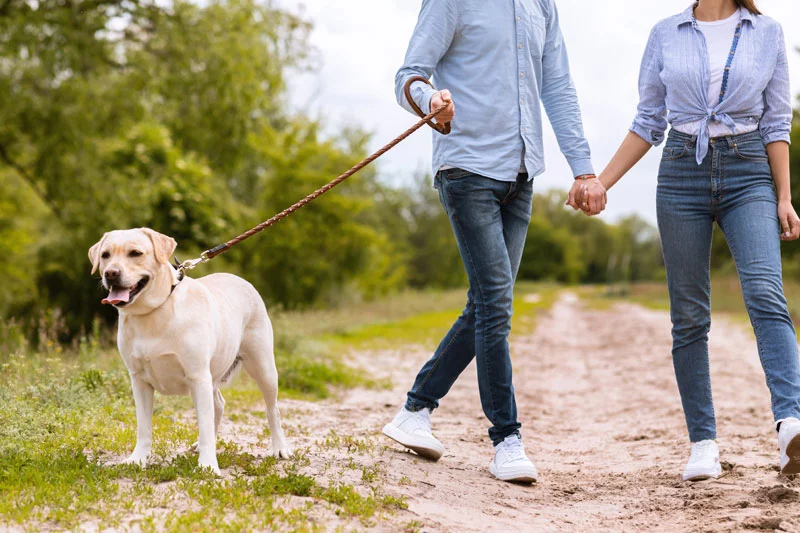How Often Should I Walk My Dog?

How Often Should I Walk My Dog?
No matter your dog’s size, senior or puppy, big or small, the animal needs routine physical activity. Exercise is a great way to keep your dog in good shape, both mentally and physically. But how often should you walk your dog? Well, if you’re wondering how many times you should walk your canine, you’re not alone. Many pet owners, especially first-time owners, ask this question often. It’s important to note that the number of times to walk your pet each day depends on a dog’s particular needs. Read on to get the answers to all the questions you may have.
How Often Should You Walk Your Dog?
We recommend that you walk your pooch, on average, 3 to 4 times a day for about 15 minutes. However, frequency also depends on the particular dog’s:
- Breed
- Eating habits
- Size, age, and health conditions
A single walk in a day can be perfect for smaller dogs, but large, high-energy dog breeds may require more walks per day. If your dog belongs to any of these categories or you’re a sporty person who enjoys outdoor activities with your dog but still unsure how much exercise your friend needs, we’ve got you covered.
Physical Activity is Good for Your Dog’s Health
Besides providing potty breaks, dog walks are good not only for your dog’s health but for your own health too. Therefore, routine walks matter and can maintain the dog’s health in various ways.
Enhances joint health – Sitting your dog at home for prolonged periods can take a toll on their joints. Walking helps keep the joints in motion and allows the animal to stay in good shape.
Digestive health – When dogs walk, they stretch, pee, and poop around the neighborhood, which is good for their health. That helps their bodies function properly, keeping the dogs’ digestive and urinary systems healthy.
Weight control – Walks are great remedies for calorie reduction. Regular walks help cut extra calories helping your dog to maintain an appropriate weight.
Higher-Energy Dog Breeds vs. Less-Active Dog Breeds
Naturally, younger, high-energy dogs benefit greatly from frequent walks, while senior dogs with mobility complications may need fewer walks. Similarly, regardless of the breed type, young dogs require more activity than older ones. A sick or injured dog may have limited ability for walks. In that case, consult your veterinarian to set up a viable exercise plan for your dog.
The higher-energy breeds include:
- Golden retrievers
- Australian shepherds
- Terriers
- Labrador and Border collies
On the other hand, low-energy dogs include:
- Mastiffs
- Great Danes
- Bulldogs
- Newfoundlands
Specific Factors Determining How Often to Walk a Dog
Age
Younger dogs often have high energy, and you can expect them to need more exercise than their middle-aged and senior counterparts. They also tend to spend more time exercising than aged dogs. Additionally, middle-aged dogs (5 to 8 years) and seniors (9 years and above) may be vulnerable to atrophy, arthritis, and other health issues like diabetes and hypothyroidism that can cut their stamina. Although aged dogs may be eager to exercise, they might not have the physical strength to keep up.
Dog Breed
The dog’s breed also determines the amount of exercise your dog needs. Working and sporting breeds like Shepherds, Pointers, and Collies tend to have higher exercise needs than lapdogs such as Papillons and Yorkshire. While some dog types are naturally sporty and athletic, some lead a relatively less active life. Of course, this could be due to a dog breed or a dog’s individual preference.
Living Conditions
Where and how you live can also determine the number of walks your dog needs. For instance, if you live in a squeezed apartment where there isn’t a lot of space for your pet to run around and explore, you may need to take your dog out for walks more frequently throughout the day. Walking allows them to spend quality time away from their usual living space, enjoy playing outside, and explore new places. On the other hand, if you live in a home with a large backyard, your canine would need fewer walks, especially if the yard has a wide-open space for them to play in, poop, and run around. However, this doesn’t mean that you substitute dog walks within in-home playing.
Health
A dog in good general shape can enjoy a 15 to 30 minute walk daily. Most breeds may need routine walks several times per day. Moreover, dogs with excellent health can enjoy long walks of up to two or more hours. Some will even hike with their owners for a couple of hours. However, dogs with health issues such as diabetes and obesity may have challenges walking for long without taking occasional breaks to relax.
If your dog isn’t in good shape, start with short walks (preferably 15 minutes) and advance gradually to long walks. Most importantly, talk to your veterinarian to know the best way to walk your dog if it’s out of shape. That said, if you live within the Lewisville area and need medical services for your dog, feel free to visit Shallowford Animal Hospital for all your dog’s treatment needs.
Regardless of age and breed, every dog needs some form of physical activity to keep them physically and mentally fit. However, the frequency and amounts are individual. Remember that dogs have different energy levels depending on their age, health, and size. Monitor your dog or consult a veterinarian to determine the right amount of walks your dog needs per day.
Share This Post
Recent Posts
About Shallowford Animal Hospital
Shallowford Animal Hospital and The Pet Spa at Shallowford are dedicated to the exceptional, compassionate care your pet deserves. Pets hold a very special place in our families, and we treat yours like our own.



